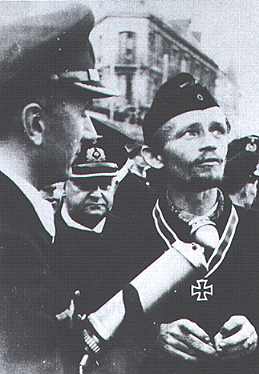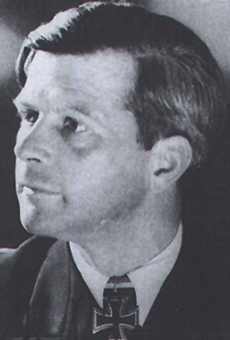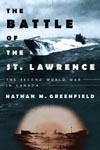The Battle of the St. Lawrence
A Little-Known Episode in the Battle of the Atlantic
by Fabrice Mosseray
In the summer of 1942, German submarines reigned supreme in the Atlantic. U-boat wolf packs ravaged Allied convoys, sinking more vessels than the Allies could build. The United States' entry into the war had brought even more German submarines to the east coast of North America. Deployed from the Barents Sea to the Gulf of Mexico, via Gibraltar and the Cape of Good Hope, they would eventually make their way into Canadian territorial waters, giving rise to a battle that is still little known both inside and outside Canada : the Battle of the St. Lawrence. Some feel this episode was a humiliation for Canada, while others see it as the price paid by the Royal Canadian Navy for fighting the enemy far from its home.
Canada at War
At the outbreak of the Second World War, Canada's economy and industry, like those of its allies, were still hard hit by the Depression, and Canada did not have the resources it needed to take on the Third Reich. The Royal Canadian Navy (RCN), which had more than 150 ships at the end of the First World War, had only six destroyers and 2,000 troops in 1939. Weakened by successive budget cuts throughout the Depression, the RCN had to rebuild its forces in a state of war, and train its officers and ratings on the fly. Tasked with supplying Britain and helping to defend that last bastion against the Nazi menace, it had no choice but to neglect the protection of its own territorial waters. The Admiralty was aware of the danger, but could only cross its fingers and hope that the U-boats would not take advantage of the situation, and would instead maintain their operations far from Canada's seaboard.
"Torpedoes away!"
When the war began in 1939, the Germans knew that the RCN was a mere shadow of its former self, and that, as in the Great War, its mission of protecting Britain and Allied convoys would seriously compromise the protection of Canada's territorial waters. Because of the importance of the port of Halifax, U-boats roamed the waters off Newfoundland and Nova Scotia, the starting-point for any convoys destined for Britain. Since they were already so close to Canada's coastline, it would be but a small step for German submarines to infiltrate the St. Lawrence, the huge river leading almost to the very centre of the country. In point of fact, however, the German navy had prepared no plans regarding the St. Lawrence, and any U-boats that entered the river did so of their own accord or by accident, as evidenced by their first attacks.
 Korvkpt. Karl Thurmann after patrol with U-553 in fall of 1942. |
The Battle of the St. Lawrence was touched off by the U-553, a U-boat which had first scoured the eastern coastline of the United States in search of convoys on the Boston-Halifax run. Engine trouble caused it to change course toward the St. Lawrence, deemed to be a calmer sector, where it could carry out repairs and then pick off easy targets. On the night of June 10, 1942 May 12, 1942 [Ed.], the night-time silence was broken by the U-553's torpedoes, which ripped through the British freighter Nicoya a few kilometres off Anticosti Island. Less than two hours later, the U-boat hunted down and torpedoed the Dutch freighter Leto, which went down in a fiery explosion. Having brought the war to less than 600 km from Quebec City, the U-553 left the St. Lawrence estuary and returned to the Atlantic.
Where are our ships?
The news of these two attacks alarmed the military and civilians alike. Bear in mind that Canada had not been directly attacked on its own territory since the War of 1812! Questions were raised from all corners as to how German submarines could have carried out such vicious attacks with complete impunity within Canada's territorial waters. Canadians, particularly Quebecers, suddenly realised that the war was on their very doorstep!
In the summer of 1942, the St. Lawrence was guarded by only one Bangor class minesweeper, two Fairmiles class motor launches, and one armed yacht. This naval force was clearly not up to the task of patrolling the 575 km long, 110 km wide St. Lawrence water route between Sept-Îles and the Gaspé coast. Even though it was reinforced by five Flower class corvettes after the U-boat attacks, it was still woefully inadequate. The incident revealed that the RCN simply did not have the resources to deal with the situation. The convoys from Canada and the U.S. that it escorted had to reach not only Britain, but also Murmansk and Archangel in the Soviet Union. Allied strategists had to set priorities: like the St. Lawrence, the Norfolk-Boston run and numerous routes in the West Indies and the Gulf of Mexico also lacked adequate protection. The St. Lawrence was considered to be a secondary objective by both the Germans and the Allies themselves. But regardless of whether it was seen as a second front, feelings ran high once again in Canada when the U-132 sank three freighters off the Gaspé coast on July 6 and damaged another on July 20. In both cases, the U-boat was able to escape attack by the corvette HMCS Drummondville (1). Long after the war, scientific advancements would reveal that the U-boats had the advantage in the St. Lawrence, as the convergence of freshwater and saltwater, together with variations in temperature, plays havoc with the sonar systems used by war vessels. Given the region's renowned fog and bad weather, it seemed that even the elements were on the side of the enemy! In spite of air patrols and escort vessels, the U-boats had the upper hand. Following attacks in August on harbours in Labrador and Newfoundland and on a convoy in the Strait of Belle Isle, the U-513, 517 and 165 set their sights on the St. Lawrence. In September, even after being detected and machine-gunned by an air patrol, the U-517 entered the St. Lawrence estuary, where it sank nine vessels and damaged another over a two-week period. Each time, it managed to escape pursuing escort vessels. The U-165 was not as lucky. Although it managed to sink the armed yacht HMCS Raccoon, it found that the St. Lawrence was not as unprotected as it had been said to be, and was continually attacked by the Royal Canadian Air Force.
The consequences of the Germans' success
Vexed by the loss of its vessels-although these losses were of little consequence-the Canadian government ordered the St. Lawrence closed to transatlantic traffic on September 9, 1942. This decision, which was more political than military, further fuelled the controversy and was an open acknowledgement of Canada's seeming inability to protect its territorial waters. It was one of the most heavily criticised decisions of the government of William Lyon Mackenzie King, one of the greatest prime ministers in Canadian history. Although King governed the country masterfully, he left military matters entirely to his commanders. Some critics felt that the Canadian military was seeking to honour its commitments to the Royal Navy no matter what the cost, to the detriment of Canada's own territorial waters. They pointed to the decision by Admiral Percy Nelles in the same year-1942-to deploy the fleet of around 20 corvettes needed to protect the St. Lawrence to the Gulf of Mexico and the Mediterranean, in support of "Operation Torch." Others saw the closing of the St. Lawrence as a wise decision, designed to reduce loss of lives, time and equipment. As a result of the closing, freight that was normally shipped to the ports of Montreal and Quebec City was sent instead to Halifax, by rail. While this placed considerable strain on the rail system, it meant that all convoys now left from the same port, with the advantage that convoys from Halifax and New York would no longer have to wait for convoys from Quebec City and Montreal before setting out for Britain. The closure in no way damaged the Allied operations, nor was it a strategic advantage for the Germans.
The German incursions certainly occasioned political fallout for Prime Minister King. In addition to being criticised by members of Parliament from the Quebec constituencies affected by the attacks, he was shaken, as was the Canadian people, by the disastrous Allied raid on Dieppe on August 19, 1942. The U-boat attacks also provided further ammunition to French-Canadian nationalists opposed to Canada's participation in the war. Since 1939, anti-government nationalists had maintained that Canada had no business in the war, which they saw as a strictly European matter. King's hopes that the German attacks would convince the nationalists to change their minds were in vain. And 1942 was also the year of a much-publicised plebiscite on conscription, which was reviled by the French-Canadian population.
With tensions already running high, more bad news came in October, when the ferry SS Caribou was torpedoed by the U-69, during a chance encounter in Cabot Strait, between Newfoundland and Nova Scotia. Of the 237 passengers, 131 perished. The U-boat managed to escape the attacks of the minesweeper HMCS Grandmère. In November, the U-518 sank two freighters and damaged another in Conception Bay, Newfoundland, en route to the Gaspé where it successfully landed a spy, further humiliating the RCN.
1943-The U-boats withdraw
But the German submarine crews would have little time to savour their victories in Canadian waters. They were instead ordered to redeploy to the North Atlantic, to hunt convoys bound for Britain. Drawing on the experience of the British and the Coastal Air Command, constant American and Canadian air patrols drove the U-boats away from the coast and back into the Atlantic. Although Canadian pilots were unable to sink a single submarine, Admiral Dönitz was impressed by the number of their attacks, and by their successfully repelling a number of U-boat missions.
Of spies and escapees
Although no U-boats ever docked in Canadian coastal villages (legends to the contrary notwithstanding), they did manage to land a number of spies, including Lieutenant Langbein in the Bay of Fundy, New Brunswick, on May 14, 1942. On November 9, the U-518 landed the agent Werner von Janowski in New Carlisle, in Chaleur Bay in the Gaspé region of Quebec. Von Janowski was caught by the Royal Canadian Mounted Police the next day, but Langbein wasn't captured until November 1944, after moving to Ottawa and spending all his money. The mission of these two unlikely spies was to keep Berlin informed of convoy movements. November 1943 brought an unsuccessful escape attempt by German submariners imprisoned at Bowanville, Ontario. The POWs were attempting to reach Chaleur Bay, where they were to be picked up by the U-536. They never reached their destination, and the RCN, once it got wind of the scheme, tried to trap the U-boat in the Bay, but it managed to get away just in time (2).
"We've lost the Battle of the Atlantic"
The year 1943 was a turning point in the Battle of the Atlantic. The U-boats continued to ravage the convoys, but they now had to deal with a different type of adversary, in the form of a much-improved Royal Canadian Navy. The RCN's ranks had swollen fifty-fold, and this had posed considerable challenges. Training for officers and ratings was rough and ready, aboard hastily built vessels. But new leaders such as Rear-Admiral Leonard Murray saw to it that crews finally received better training, and that ships were equipped with better weapons and detection systems. The RCN no longer catered to the every whim of the Royal Navy, to the detriment of Canada's own protection. RAdm Murray had other ideas, and became Commander-in-Chief Canadian Northwest Atlantic. He was the only Canadian to command an Allied theatre of operations in the Second World War. The better trained and better equipped Canadian crews, who made up 48% of the Atlantic convoy escorts, were much more effective allies, and were more than a match for the U-boats. As a result, in late 1943, Grand Admiral Dönitz, who had just lost his son, a submariner, stated : "We've lost the Battle of the Atlantic!" The U-boat wolf packs had become flocks of lambs, and the St. Lawrence was reopened in April 1944.
1944-The Reich strikes back
U-boats were increasingly conspicuous by their absence in Canadian waters in 1943. Mines were laid off Halifax, and the U-537 managed to install an automated weather station in Labrador (3). The Kurt station was similar to the ones the Germans installed in Greenland, Bear Island and Spitsbergen. U-boats did not return to Canadian waters until 1944, when the Allied armies were poised to invade Germany itself. The average life of a U-boat was only three missions, so the crews were always eager to find easy targets. The submarines were equipped with a snorckel, a telescopic system allowing them to provision themselves at sea and recharge their batteries without having to surface. Using this system, the U-1223 entered the St. Lawrence undetected, seriously damaged the frigate HMCS Magog on October 14 and damaged the Canadian freighter SS Fort Thompson on November 2. Three weeks later, in Cabot Strait, the U-1228 torpedoed the corvette HMCS Shawinigan, making it the last victim of the Battle of the St. Lawrence. These German attacks, though very limited, momentarily reawakened the fears experienced two years before. In May 1945, the U-boat menace finally came to an end when the U-889 and U-190 surrendered to the Canadian Navy, at Shelburne, Nova Scotia and Bay Bulls, Newfoundland.
Conclusion
Although the St. Lawrence River was never a major target for German strategists, it was the site of sporadic U-boat attacks, as the Germans knew that convoys were inadequately protected and that the RCN was short of ships and was more concerned with protecting Britain than Canada's own waters. Neither the number of ships sunk nor the closure of the St. Lawrence provided any strategic gain to the Third Reich. Of the 2,500 vessels sunk during the Battle of the Atlantic, only 23 (including three warships) were sunk by half a dozen U-boats in the Gulf of St. Lawrence. The Battle of the St. Lawrence was ultimately won in the Atlantic, where Canadian crews distinguished themselves. The RCN won increasing success as it gained more experience and better equipment. It made 25,343 crossings, delivered 165 million tonnes of provisions and equipment, and destroyed 33 German and Italian submarines. At war's end, the Royal Canadian Navy was the third largest naval power in the world, with 90,000 men and 400 vessels.
- HMCS is the abbreviation of Her Majesty's Canadian Ship, and always precedes the name of a Royal Canadian Navy vessel. This practice is a direct heritage of the Royal Navy. The names of British warships are always preceded by HMS, Her Majesty's Ship, and this practice has been continued in all Commonwealth navies.
- The U-536 lucked out that time, but the RCN was to have the last word: the corvette HMCS Calgary sunk the U-boat off the Azores on November 20, 1943.
- The station, a simple shelter made of wooden boards, was not discovered until 1981.
Acknowledgements:
The author wishes to thank Luc Bertrand (author of L=énigmatique Mackenzie King, published by Éditions Interligne), André Kirouac (Director of the Naval Museum of Quebec), Paul-Henri Bouchard (Second World War Royal Canadian Navy veteran), and Nathalie Hanno.
Bibliography:
German, Tony. The Sea is at Our Gates: The History of the Canadian Navy. Toronto : McClelland & Stewart, 1990, 360 pages.
Hadley, Michael. U-boats Against Canada: German Submarines in Canadian Waters. Montreal, Kingston, London and Buffalo : McGill-Queen's University Press, 1990, 362 pages.
Sarty, Roger. Le Canada et la bataille de l'Atlantique. Montreal : Art Global, 1998, 167 pages.
Schull, Joseph. Lointains navires. Ottawa : Edmond Cloutier, 1953, 605 pages.
This article was published on 29 Mar 2002.
Buy this title at amazon.co.uk |
Books dealing with this subject include
|


